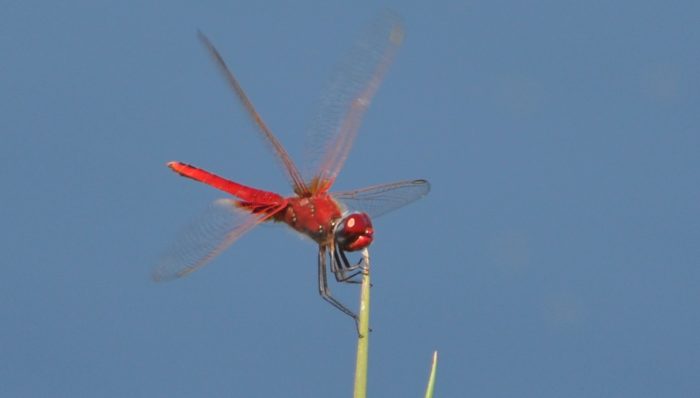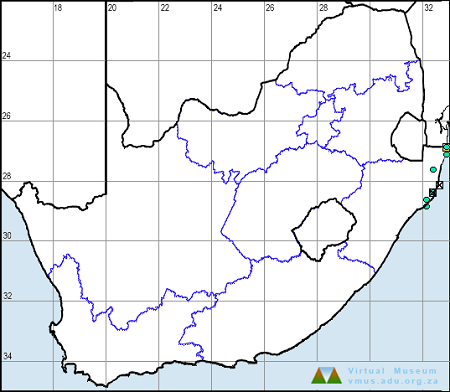Cover photo by Diana Russell.
Find the St. Lucia Basker in the FBIS database (Freshwater Biodiversity Information System) here.
Family Libellulidae
Identification

Richards Bay, KwaZulu-Natal
Photo by Richard Johnstone
Medium-large size and robust
Length attains 46mm; Wingspan reaches 84mm.
The St. Lucia Basker is a deep red species with extensive dark amber panels at the base of the wings.
It is easily confused with the Red Basker (Urothemis assignata), but is larger and has extensive amber patches at the base of the forewings. These are much reduced or absent in Urothemis assignata. Both sexes of Urothemis luciana have 8 or 9 Ax veins in the forewing. (Urothemis assignata has 7 Ax veins in the forewing).
Click here for more details on identification of the St. Lucia Basker.
Habitat
The St. Lucia Basker inhabits the subtropical wetlands of coastal north-eastern KwaZulu-Natal. It is found in the vicinity of both perennial and seasonal marshes, swamps and pans. This species favours wetland/forest mosaic where trees, bushes and grassland are found in close proximity to wetlands.

Photo by Ryan Tippett
Behaviour
The St. Lucia Basker is far more aerial than other Urothemis species and spends less time perched at the waters edge. It is most often seen on and around trees and bushes, with an abundance of long grass and water nearby. The St. Lucia Basker perches conspicuously on top of trees, bushes and reeds etc. The flight is fast and powerful. It’s movements and life history are not yet fully understood.

Kosi Bay, iSimangaliso Wetland Park, KwaZulu-Natal
Photo by Ryan Tippett
Status and Conservation
Urothemis luciana is an uncommon to rare species with an erratic occurence. This species is not present at the same sites every year and appears to vanish during prolonged dry years, only to re-appear again after good rains. The St. Lucia Basker is listed as Near Threatened in the IUCN Red List of Threatened Species. A significant portion of its South African range is protected within the iSimangaliso Wetland Park. The St. Lucia Basker is not known to occur at artificial habitats and is sensitive to habitat degredation.
Distribution
The St. Lucia Basker is endemic to north-eastern KwaZulu-Natal and southern Mozambique. It occurs as far South as Richards Bay.
Below is a map showing the distribution of records for St Lucia Basker in the OdonataMAP database as at February 2020.

Below is a map showing the distribution of records for St Lucia Basker in the OdonataMAP database as of December 2024.

The next map below is an imputed map, produced by an interpolation algorithm, which attempts to generate a full distribution map from the partial information in the map above. This map will be improved by the submission of records to the OdonataMAP section of the Virtual Museum.


Further Resources
The use of photographs by Diana Russell and Richard Johnstone is acknowledged. All other photographs by Ryan Tippett.
St. Lucia Basker Urothemis luciana Balinsky, 1961
Other common names: St. Lucia-sonvangertjie (Afrikaans)
Recommended citation format: Loftie-Eaton M; Navarro R; Tippett RM; Underhill L. 2025. St. Lucia Basker Urothemis luciana. Biodiversity and Development Institute. Available online at https://thebdi.org/2020/02/25/st-lucia-basker-urothemis-luciana/
References: Tarboton, M; Tarboton, W. (2019). A Guide to the Dragonflies & Damselflies of South Africa. Struik Nature.
Samways, MJ. (2008). Dragonflies and Damselflies of South Africa. Pensoft
Samways, MJ. (2016). Manual of Freshwater Assessment for South Africa: Dragonfly Biotic Index. Suricata 2. South African National Biodiversity Institute, Pretoria

